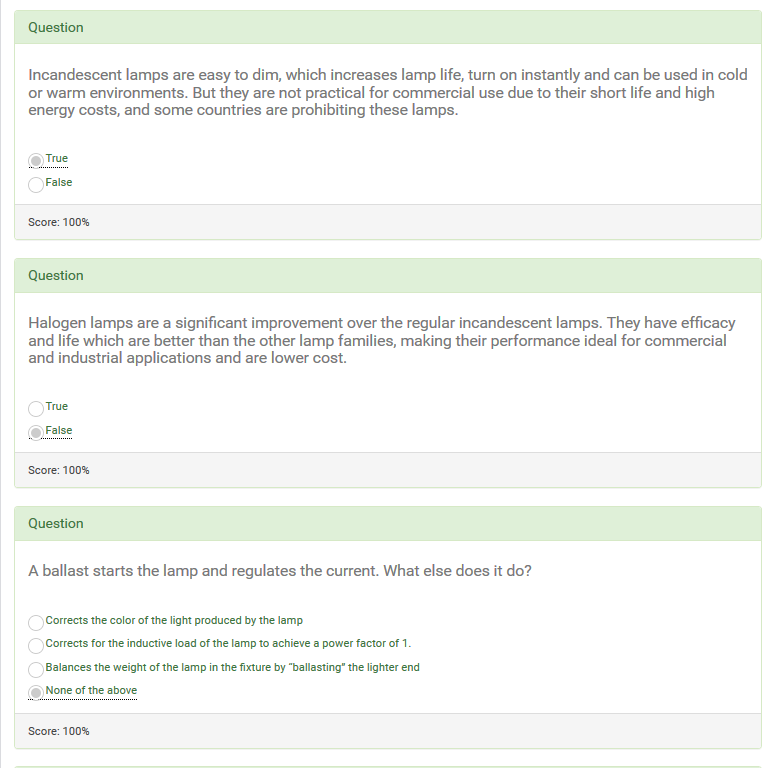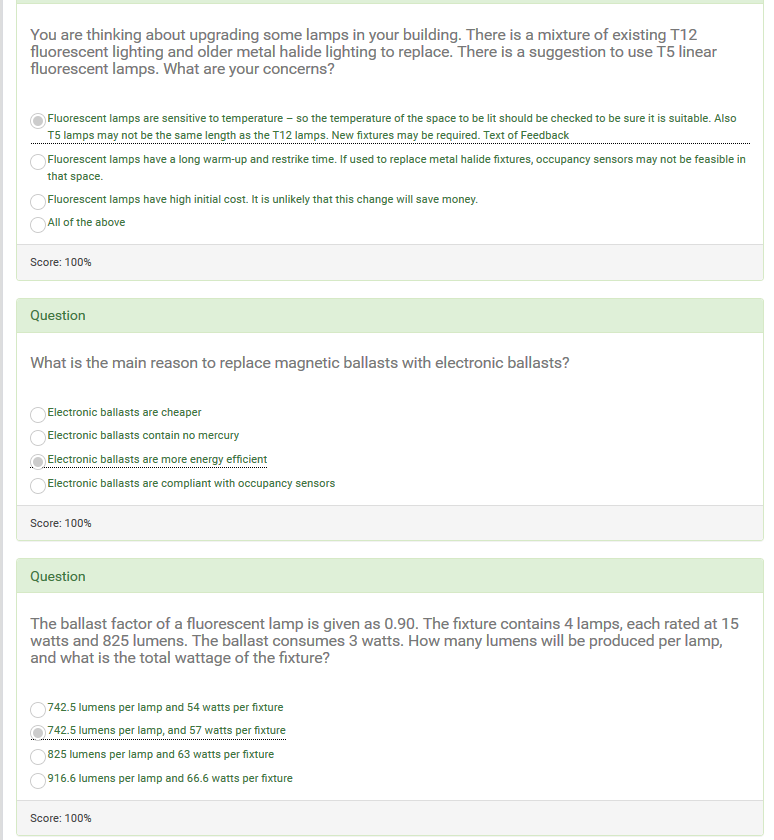Low pressure sodium and linear fluorescent lamps tend to have long life and very good lumen maintenance. Incandescent lamps have good lumen maintenance but short life.
In a batch of 1,000 lamps, how many would you expect to fail before the mid-life stated by the manufacturer ?
Which of the following statements is NOT true ?
Incandescent lamps are easy to dim, which increases lamp life, turn on instantly and can be used in cold or warm environments. But they are not practical for commercial use due to their short life and high energy costs, and some countries are prohibiting these lamps.
Halogen lamps are a significant improvement over the regular incandescent lamps. They have efficacy and life which are better than the other lamp families, making their performance ideal for commercial and industrial applications and are lower cost.
- True
- False
In a batch of 1,000 lamps, how many would you expect to fail before the mid-life stated by the manufacturer ?
- None
- 5%
- 50%
- 95%
Which of the following statements is NOT true ?
- Lamps which are left on constantly will have longer life measured in burning hours
- Lamps which are turned off when not in use will have a shorter life measured in burning hours, but will save energy by eliminating wasted burning hours
- Lamps which are turned off when not in use have a longer life measured in burning hours.
- Lamps which are turned off when not in use will typically have a longer life measured in calendar months, by distributing the burning hours over more days.
Incandescent lamps are easy to dim, which increases lamp life, turn on instantly and can be used in cold or warm environments. But they are not practical for commercial use due to their short life and high energy costs, and some countries are prohibiting these lamps.
- True.
- False
Halogen lamps are a significant improvement over the regular incandescent lamps. They have efficacy and life which are better than the other lamp families, making their performance ideal for commercial and industrial applications and are lower cost.
- True
- False.
A ballast starts the lamp and regulates the current. What else does it do?
- Corrects the color of the light produced by the lamp
- Corrects for the inductive load of the lamp to achieve a power factor of 1.
- Balances the weight of the lamp in the fixture by “ballasting” the lighter end
- None of the aboveYou correctly checked this.
You are thinking about upgrading some lamps in your building. There is a mixture of existing T12 fluorescent lighting and older metal halide lighting to replace. There is a suggestion to use T5 linear fluorescent lamps. What are your concerns?
- Fluorescent lamps are sensitive to temperature – so the temperature of the space to be lit should be checked to be sure it is suitable. Also T5 lamps may not be the same length as the T12 lamps. New fixtures may be required. Text of Feedback.
- Fluorescent lamps have a long warm-up and restrike time. If used to replace metal halide fixtures, occupancy sensors may not be feasible in that space.
- Fluorescent lamps have high initial cost. It is unlikely that this change will save money.
- All of the above
What is the main reason to replace magnetic ballasts with electronic ballasts?
- Electronic ballasts are cheaper
- Electronic ballasts contain no mercury
- Electronic ballasts are more energy efficient.
- Electronic ballasts are compliant with occupancy sensors
The ballast factor of a fluorescent lamp is given as 0.90. The fixture contains 4 lamps, each rated at 15 watts and 825 lumens. The ballast consumes 3 watts. How many lumens will be produced per lamp, and what is the total wattage of the fixture?
- 742.5 lumens per lamp and 54 watts per fixture
- 742.5 lumens per lamp, and 57 watts per fixture.
- 825 lumens per lamp and 63 watts per fixture
- 916.6 lumens per lamp and 66.6 watts per fixture
Which of the following statements is true?
- Lumen depreciation is the percentage of light lost from a lamp at mid-life
- Lumen maintenance is the percentage of light produced by a lamp at mid-life
- Lumen depreciation + lumen maintenance = 100% of initial lumens
- All of the above.





Comments
Post a Comment